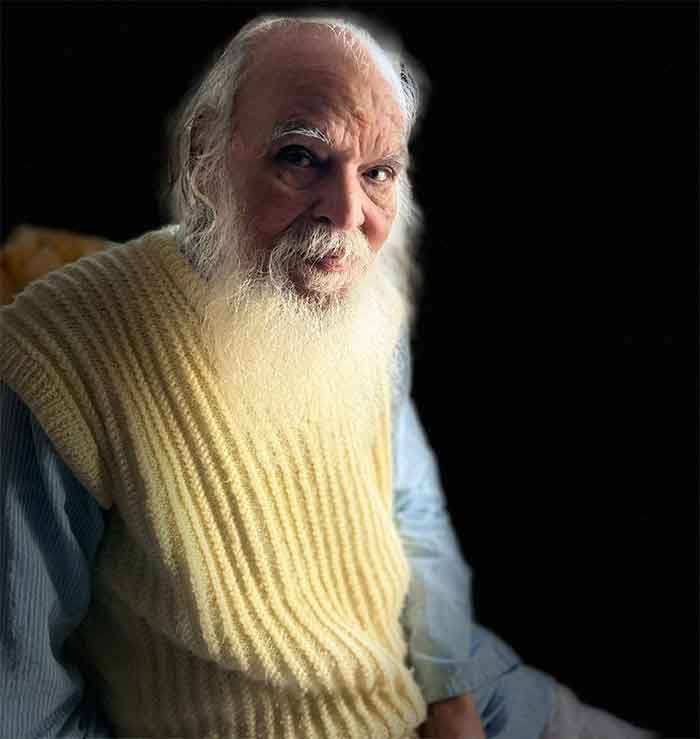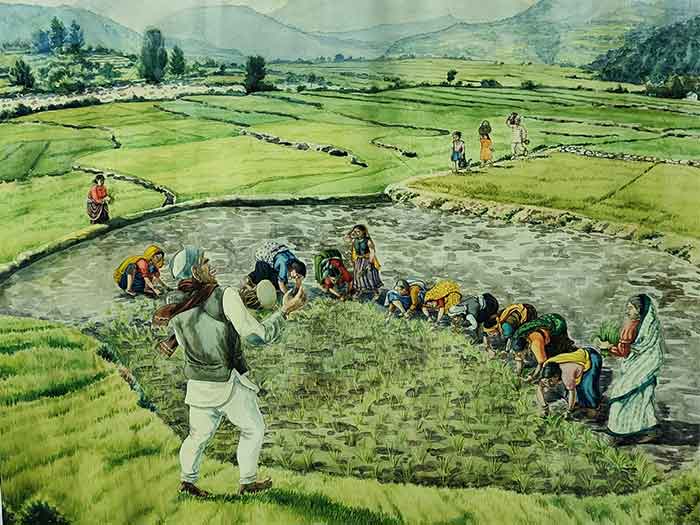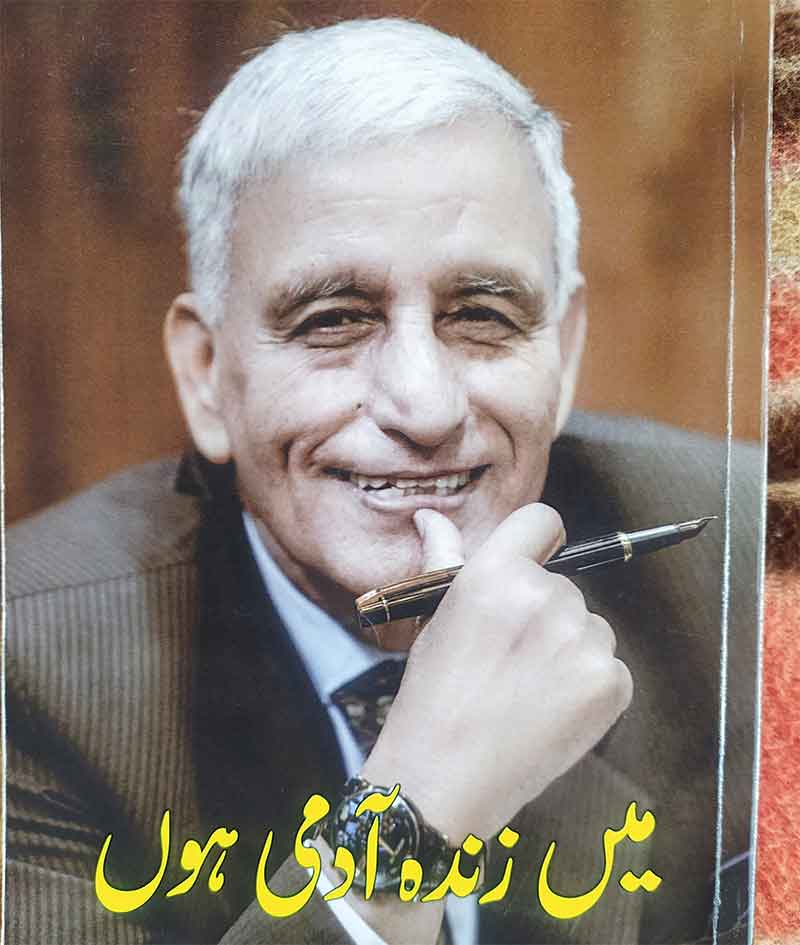
Bumping into him for the first time did give me the feel of standing face to face with a 19th century rustic, straight from the pages of some musty volume by Tolstoy, Turgenev or Chekhov. A tall robust frame, broad forehead with a receding hairline, big spatulated palms -he was draped in a coarse khadi dhoti-kurta and was putting on ordinary flip-flop slippers. I could make it out that his was an arcane profile.
Known in both sides of Atlantic for his original work in the field of prehistoric archaeology, especially the cave and rock art, Dr Yashodhar Mathpal is also a gifted painter and has to his credit several solo exhibitions in India and abroad.
Speedily degenerating environment and the eco-degradation consequent upon the paradigm shift in values and traditions in the vast swaths of the Central Himalayan hills- the region he belongs to -have over the decades become such a grave concern for him that at times he finds it difficult to hide his cantankerousness on this issue. For the last few decades through his writings, spoken words, paintings and his unique collection of antique objects and archaeological finds, representing the eco-friendly life style as it was in the days of yore, he has been trying to educate the masses, especially the youngsters, in the ethics of environment and ecological balance – which he refers to as “the indispensable twin requirement of quality life.” Exhausting a major part of his earnings he has setup three huge art galleries in an area of over seventeen thousand square feet in his residence called Geeta Dham at Bhimtal in the state of Uttarakhand. Having to his credit the experience of setting up quite a few museums in the central India and elsewhere, realizing his long-cherished dream of initiating a personal one as a representative setup of the environment, art and ethnic-culture of the vast central Himalayan region must not have been a difficult task for him, at least technically. However, getting three huge art galleries constructed and that too without receiving any financial assistance from the government or any other source, was definitely not an easy accomplishment even for this ingenuous and intrepid Gandhian.

Criss-crossed by the vivid perception of a trained archaeologist and sentimentality of a spontaneous artist, the museum of Mathpal is an authentic commentary on the role of the unique environment of the central Himalayan expanse in conditioning the regional life, art and culture as they were in the days gone by. Looking at the various artifacts, implements, wearing, papers and his own paintings, a visitor inside the museum may feel and understand that besides a wholesome diet how the regional inhabitants would meet most of their requirements from the locally available resources and how all that was taken would finally get returned to the nature.
It indeed is an astounding experience to reconstruct the whole gamut of life as it was then, taking a lead from a variety of objects displayed in the museum. Astounding, because here you see centuries old hand printed garments made of locally available fiber and they haven’t yet lost their original sheen. The locally available fiber of Sisal and Grevia is hardly used now. You notice here the kiln backed bricks of considerable antiquity used by early herder settlers to make chambers for storing grains. Interestingly, brick baking hasn’t been in practice here at least for a couple of centuries. A hoard of agricultural implements made of locally mined iron have also been unearthed by him from a nearby ravine. It is a testimony to the hard labour put in by early agriculturists while cutting stepped fields on the face of mountains. An amazing collection of wooden utensils, once a common household belonging in hills, is also there. This art was once practiced by the Van Raji tribals whose population is speedily dwindling. A land record on hand-made paper called ‘badua kagaz’ dating back to the Chanda dynasty that surfaced up in this region way back in 6th century AD, is also there. It has evidences to show that how community assets like pastures, springs etc. were taken care of. The lyrical water colour paintings of Dr Mathpal displayed here project an authentic picture of quite a few eco-friendly traditions associated with the day-to-day life -like extracting sap from the branches of Grewia tree for washing hairs or filtering the potassium rich ash of cobs to be used as detergent mixing it with rice polish. A beautiful painting captures the celebration of Harela or festival of greenery at the advent of monsoon.

The fascinating objects displayed in the museum combining with his explanatory monologue waft the visitors deep into the corridor of time -when bulldozing the mountains with Pokland and JCVs was not a way of life. Coming out of the museum one cannot help realizing that how respectful and considerate our ancestors had been in their relationship with the environment well before the expressions like carbon footprints, eutrophication, greenhouse effect etc. were coined. Also, that how stupid it is for their inheritors to sit gratified on the gunpowder keg thinking that it is dampened for ever and ever.
He has been conferred upon the Padma-award and the state govt made him the vice president of the cultural council offering him a beaconed car and other fanfare (which he of course did not accept). Ministers, including the CMs of the state and other big-wigs have been visiting his museum right since the inception of the state. Many a times substantial grants have been announced by these ministers and their cohorts for the museum in public functions amidst massive cheering and clapping. It all gets covered in the regional press quite prominently but so far no funds have been released. In his recently released autobiography, he speaks without mincing his words of the high-ups and their hangers-on asking him on their visit to his museum to prepare a project report doubling the required amount, so that they may pocket the inflated half in lieu of the service rendered for getting the grant released. “No one in this callous system” he rues, “did ever try to understand me or sympathies with my vision. I am an octogenarian now; I never ran after money or materialistic gains throughout my life. My only concern is to make this museum self-financing so that it continues even after I am gone.”
An experienced curator and archaeologist that he is, all the three galleries of the museum have been set in a standard manner. All he wants from the government is a corpus sufficient enough to provide regular salaries to a handful of employees he wants to have to look after the museum. “With the advancing age It has now become difficult for me to put in he the required physical labour for maintaining this museum, to ensure the safety of the rare and perishable displays and keep the things clean,” says he. The nonchalance of the government and the administration may well be understood by the fact that despite being praised by the scholars the world over and being located along the highway on which runs the tourist traffic to the various destinations in hills, the museum hasn’t yet been put in the tourist circuit developed by the state govt and its agencies. He has requested for this favour several times but save assurances nothing has been achieved so far. A documented remark made on him by Prof Dr Majeed Khan Advisor, Deputy Ministry of Antiquities and Museum, Kingdom of Saudi Arabia, in the tribal art conference organized by the Asiatic Society at Kolkata in March 2005 hasn’t yet lost its edge. It reads-
“I must say that I never met a person of your knowledge, a great artist, scholar, rock art specialist and a man of religion but not fanatic….. I am surprised that your valuable contribution to both the ancient and present art, and your efforts to highlight the image of India in general and that of the traditional, tribal, social and cultural values all over the world have not been recognized officially by the Govt of India and that of your region…”
The five acres of sprawling slopes at the back of the museum in Geeta Dham -once a sear and brown landscape -is full of the woody vegetation now, of which around three hundred species have been documented by his son, a trained forester. Over fifty species of birds have taken permanent shelter here. This forest has been grown by Mathpals at the altitude technically known as problem zone due to excessive biotic interference. The well-organized forest and land mafia of this region has been eying it for long and a case agaisnt illegal felling and extraction of wood by these goons in this forested area, has been filed by him in the district court.
On the wrong side of eighties Dr Mathpal is more like a tired soldier who finds it difficult to withdraw from the din of an on-going battle. He bids me an adieu with these words putting his heavy hand on my shoulders. – “My life, whatever little I could achieve and this museum are all well directed endeavours to establish that a happy, satisfied and meaningful life can be lived in complete harmony with nature, without assuming an aggressive attitude towards it…”
The childlike innocence in his eyes, I know it well, will keep on haunting me for long.
Rajshekhar Pant is a freelance writer, actively associated both with print and electronic media. Conferred CSE media fellowship 4 times. From Uttarakhand hills. [email protected]
















































